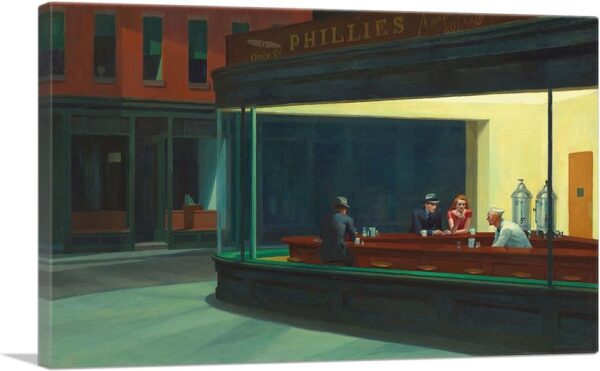“Nighthawks”: Edward Hopper’s Illumination of Urban Isolation
Introduction:
“Nighthawks” (1942) by Edward Hopper stands as a quintessential piece of American realist art, a timeless masterpiece that transcends its era to captivate and resonate with viewers across generations. This iconic painting immortalizes a solitary, late-night diner, bathed in the ethereal glow of fluorescent lights against the backdrop of a dark cityscape. The figures within, lost in their own thoughts, emanate a palpable sense of isolation and urban anonymity. Hopper’s meticulous attention to light and shadow, coupled with his remarkable ability to evoke a mood of quiet contemplation, makes “Nighthawks” a work of art that invites us to reflect deeply on the intricacies and challenges of modern urban life.
The Lonely Diner: A Glimpse into Urban Anonymity
As we delve into the realm of “Nighthawks,” our gaze is immediately drawn to the diner, a silent witness to the ebb and flow of urban life after dark. The scene is painted with a careful consideration of details – the stark contrast between light and shadow creates a haunting ambiance, casting a surreal glow on the figures within. The patrons, seated in isolation, seem both physically and emotionally distant from one another, each encapsulated in their own private universe. Hopper masterfully captures the essence of urban loneliness, portraying the diner as a microcosm of the city itself – bustling yet isolating.
The Play of Light and Shadow: Hopper’s Artistic Mastery
One of the defining elements of “Nighthawks” is Hopper’s keen understanding of light and shadow. The fluorescent lights that illuminate the diner’s interior not only provide a stark contrast to the enveloping darkness outside but also serve as a metaphor for the harsh realities of modern life. The interplay of light and shadow creates a chiaroscuro effect, intensifying the emotional impact of the scene. It is through this meticulous attention to detail that Hopper brings life to his subjects, infusing the canvas with an almost palpable sense of quiet despair.
Evoking Contemplation: A Timeless Reflection on Urban Life
“Nighthawks” transcends its temporal origin, resonating with audiences today just as it did in the 1940s. Hopper’s ability to evoke a mood of contemplation makes the painting a timeless exploration of the human condition in an urban setting. Viewers find themselves drawn into the silent conversations of the figures within the diner, compelled to ponder the complexities of their own lives. The painting becomes a mirror reflecting the challenges of modern existence, inviting us to confront our own sense of isolation and introspection in the midst of the bustling urban landscape.
Conclusion: A Masterpiece that Endures
Edward Hopper’s “Nighthawks” continues to stand as a testament to the enduring power of art to provoke thought and introspection. The painting’s ability to capture the essence of urban isolation and anonymity, combined with Hopper’s mastery of light and shadow, elevates it to the status of a true masterpiece. As we gaze upon the haunting scene of the late-night diner, we are reminded that the themes explored by Hopper are not confined to a specific time or place but resonate across the tapestry of human experience. “Nighthawks” invites us to peer into the soul of the city, prompting a timeless reflection on the complexities and challenges of modern urban life.

